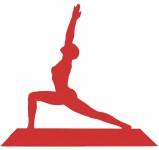Benefits of Vinyasa Yoga
Vinyasa “Flow” yoga is the act of connecting various yoga poses together to form a continuous stream of motion that stresses the link between postures and breathing (and therefore the body with the mind). Unlike some forms of yoga, Vinyasa leaves room for variety—how it is implemented depends on the style of the teacher. The commonality in different teaching methods lies in the unification of movement and breath as the flow of one pose to the next is stimulated with an inhale or exhale of breath. Many times a faster-paced practice, many “power yoga” classes incorporate elements of strength training with Vinyasa practice.
Physical Benefits
Any form of yoga will provide physical benefits, helping you to gain balance and flexibility. With Vinyasa, you will particularly notice an increase of stamina and endurance. As one practices yoga on an everyday basis, his or her muscles strengthen and stretch and the body heals itself.
In conjunction with the increased stamina comes improved balance and coordination. The body becomes revitalized and its ability to heal is enhanced by stretching, strengthening and breathing techniques. An increased body heat and energy will create looser muscles as well as stronger blood flow, carrying oxygen to essential organs for revitalization.
Emotional Benefits
While the physical body is revitalized during consistent yoga practice, the mind will be as well. Breathing techniques that help you gain balance and control over your body also center your state of emotional well-being. As you have conscious control over your body and its breathing, you become more aware of your body and its restrictions and potential. Allowing yourself to put the time aside for regular yoga practice will calm tension in your muscles, lower anxiety and reduce depressive tendencies. An increased sense of calmness filters into the rest of your life beyond the yoga class
Concentrating on the core breathing of your body brings the focus to your inner being and away from the outside world, including any distractions that may plague your life outside of yoga. An increased sense of calmness filters into the rest of your life beyond the yoga class. This self-awareness can combat anti-depression and increase motivation as you feel a closer connection to the way your body functions.
These two types of benefits—physical and mental—work hand in hand and feed each other: As you mentally relax, your muscles physically relax and you open your body up for increased possibilities. As you practice physical activity, you inwardly become more perceptive, nurturing the development of mental awareness.
Popular Sequences
These popular sequences of poses are common in the practice of Vinyasa because of the natural flow between movements:
- Standing Pose Sequence: Downward facing dog, Lunge, Warrior I, Warrior II, Extended side angle, Triangle, Half moon and back to Downward facing dog
- Sun Salutation Sequence: When teachers tell the class to “go through their vinyasa,” they are referring to the sun salutation sequence that varies but usually flows as such: downward facing dog to plank position, forward into cobra and back to downward facing dog.
Don’t Forget
Because Vinyasa is a strength-training form of yoga, always keep former injuries in mind, be aware of your physical limitations and what your body can handle. When considering any new exercise regiment, consult your doctor. Drinking the recommended daily amount of water will prevent dehydration during your workout. Most classes run from 45 to 90 minutes long, starting with sun salutations and standing postures and continuing with several other categories of poses before ending with a meditation series.
steroids online
Related posts
14390 total views, 1 today






